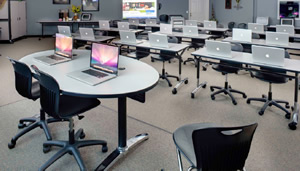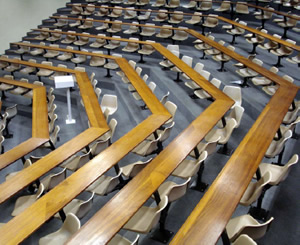Built for Comfort
- By Brandon Barrett
- 10/01/13

PHOTO COURTESY OF VIRCO, INC.
The science of ergonomics is “an applied discipline concerned with designing and arranging things people use so that the people and things interact most efficiently and safely,” according to Miriam-Webster’s dictionary. The ideas of efficiency and safety have long been standards held in the industrial and corporate worlds, but are now influencing the designs of furniture makers and purchasing decisions of college administrators as well. Many colleges have recognized that classroom safety is a key issue for prospective students and their parents. While much of the recent media coverage has focused on campus security, there is a growing body of research that shows students are also at risk when it comes to poorly designed furniture in the classroom.
Problems that can be caused by ergonomically unfriendly classroom furniture include sore hips, shoulders, back and neck, along with eye irritation and discomfort. Without access to ergonomically correct workspaces, many researchers believe that colleges are in danger of creating a generation of students that is more prone to workplace injuries.
ONE SIZE DOESN’T FIT ALL
Another interesting aspect of classroom ergonomics is that furniture makers must design furniture for a diverse array of student body-types. Can a chair or desk be simultaneously suited for both a 5-foot-1-inch freshman nursing student as well as a 6-foot-11-inch senior on the basketball team? Many designers and ergonomic researchers are dedicated to solving just that problem, and are working collaboratively to try and cut down on student injuries. “It is important to allow for some degree of adjustability in furniture to accommodate a wide range of uses, “notes Alan Hedge Ph.D., a professor in the Department of Design and Environmental Analysis at Cornell University. “In the new classrooms that we have in our college we have actually put ergonomic task chairs that provide good adjustability for a range of students who are working at a fixed-height table,” says Dr. Hedge.
Adjustable chairs and tables can provide great relief for students of all sizes, providing them with the ability to tailor workspaces to meet their individual needs. Having easily adjustable furniture also makes college classrooms more versatile, allowing professors to customize desk and chair size settings based on their course’s space requirements (science lab, discussion table, etc.). The versatility of ergonomic classroom furniture, along with its promise of student wellness, makes it an easy buy for college administrators and facility planners. Designing the elements of an ergonomically correct workspace, however, takes careful planning and expert design.
Many furniture companies work with college administrators, professors and even student populations to learn about the ways in which classroom furniture affects performance and health. Designers are careful to evaluate the environment their product would inhabit and what features could be most useful. Next, multiple prototypes are designed and built, focusing on design principles that will benefit the greatest number of students.
Once the prototypes are completed, the next step is to initiate the testing phase. This step requires manufacturers to test their prototypes using students of varying heights and weights. Some companies even perform ergonomic testing using those a bit closer to the process, such as employees and designers.
Kristen Dixon, vice president of business development at MooreCo, Inc., an Austin-based furniture manufacturer emphasizes the importance of employee and designer testing. “We have employees of all sizes that can help test a prototype, which really helps us to get close to the product and note its strengths and what needs work,” Dixon says. “It helps to be a part of the process at every step.”

PHOTO COURTESY OF VIRCO, INC.
SITTING IN COMFORT. According to the Cornell University Ergonomics Web, chairs can be covered in a variety of upholstery materials, each of which has benefits and concerns. Vinyl and vinyl-like coverings are easy to clean and spill resistant, but they don’t breathe and, if the chair begins to heat up under a sitter’s thighs, uncomfortable amounts of moisture can accumulate. Cloth upholstery is the most common covering, but this is less resistant to spills and more difficult to clean. A cloth covered seat pan can also become warm and moisture-laden, and cloth-covered foam seat pans can be a significant source of dust mite allergen. When selecting your chair covering, think about cleaning and maintenance issues and plan appropriately.
The results of these tests are often compared against existing models of classroom furniture, to see what, if any, ergonomic improvements have been made. Finally, a team of designers is called in to sharpen the aesthetic elements of the prototype, making it both functional and attractive.
THE IMPACT OF TECHNOLOGY
Although the design process for ergonomic furniture is fairly straightforward and beneficial, there are new aspects of on-campus life that furniture makers cannot work to improve. The wide availability of new technologies, although great for educational purposes, have created a new host of issues related to ergonomics.
The student workspace is quickly evolving from a desk to almost anywhere, thanks to the affordability and convenience of modern laptop computers. Everyday study activities include students slumping, sitting and leaning in front of their laptops or other workstations, causing significant harm to bones and joints. As these workspace habits become more commonplace, so do the injuries associated with them.
“Laptops are inherently more problematic than desktops because the screen and the keyboard typically are connected, and this means that when the keyboard is in a comfortable position the screen is likely to be in a suboptimal position, and vice versa,” says Dr. Hedge.
Dr. Hedge is quick to point out that many colleges have not yet recognized the significance of laptop-related ergonomic problems, nor made any attempt to minimize the risks they present. “It is time for schools, colleges and universities to take the need for a comprehensive ergonomics program seriously, otherwise we are potentially priming a generation of workers for injury in the workplace,” he says.
Cornell, along with a handful of other institutions, is providing ergonomic guidance in a place many students are sure to frequent: the Web. On their ergonomics website, Cornell University Ergonomics Web (www.ergo.human.cornell.edu), the university provides everything from ergonomic news and developments to workspace safety tips.
STEP-BY-STEP IMPROVEMENTS
While providing large-scale ergonomic resources can seem daunting, there are also many small measures professors, administrators and students can take to improve on-campus ergonomics. Some of the measures that can be taken are simple, like adjusting the distance of your computer screen from your face. Other ways can be more involved and include buying new furniture and workspace accessories. Here are a few tips for quickly and easily improving workspaces:
- Place wrist-rests along the front of keyboards
- Make sure computer monitors are directly aligned with keyboard and mouse
- Place computer monitors at a right-angle to all windows
- Use lumbar cushions in chairs that lack proper back support
- Install an adjustable tray for keyboards
- Purchase height-adjustable furniture for classrooms and computer labs
- Consider placing document-holders in front of computers for easy typing and reading

PHOTO COURTESY OF IAN BARBOUR
When planning larger, more complex ergonomics-enhancement projects, it is important to utilize many resources in an effort to acquire the most up-to-date furniture at the best price. Some resources offer project inquiries and statistics relating to ergonomics in the classroom. It is also crucial to contact larger furniture manufacturers to get detailed price quotes and design information.
Other details that should be considered are the intended use and placement of the furniture once it is purchased. While ergonomically correct classroom furniture is quite versatile, furniture makers have also started to design ergonomic pieces for a wide range of specialized environments. Many manufacturers offer pieces suited for science labs and libraries, along with standard classroom models.
Once all information has been gathered and quotes have been evaluated, a clearer picture of the most viable product options should come into focus. Regardless of the choice, the benefits of ergonomics continue to grow in relevance. Purchasing ergonomic furniture is an investment in both classrooms and your student population that will continue to offer benefits far into the future.
This article originally appeared in the College Planning & Management October 2013 issue of Spaces4Learning.